Content
Published:
This is an archived release.
Improved conditions in manufacturing
Norwegian industrial managers experienced stronger growth in total output during the first quarter. Larger volumes within several industries, due to an increase in the demand from export markets, explain this rise.
| 1st quarter 2014 | ||
|---|---|---|
| Changes from previous quarter | Expected changes in next quarter | |
| 1A diffusion index is compiled using the estimated percentages on "ups" and "same" according to the formula: (ups + 0,5 * same). The diffusion index has a turning point at 50. An index value above 50 indicates growth in the variable, and opposite for a value below 50. | ||
| Total volume of production | 55.7 | 57.0 |
| Average capacity utilisation | 54.5 | 55.3 |
| Average employment | 51.7 | 48.6 |
| New orders received from home markets | 50.8 | 54.1 |
| New orders received from export markets | 55.9 | 54.1 |
| Total stock of orders | 54.1 | 53.5 |
| Prices on products at home markets | 55.1 | 57.2 |
| Prices on products at export markets | 54.1 | 53.0 |
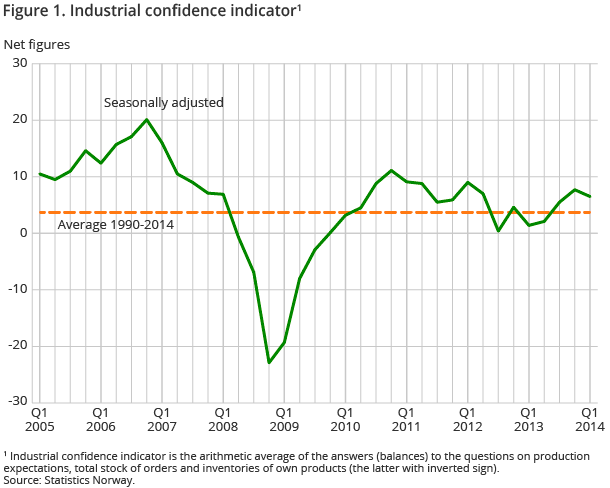
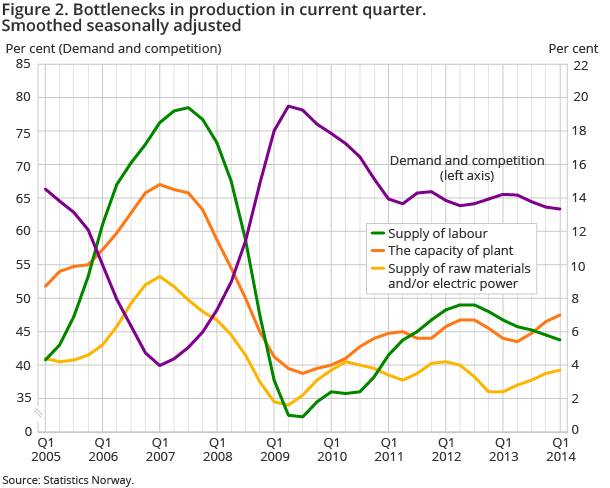
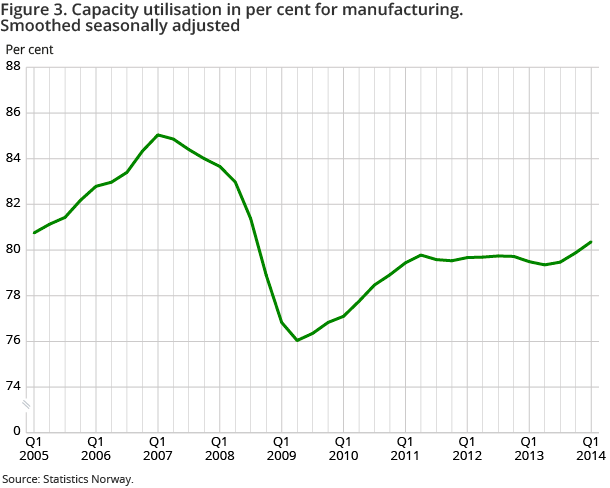
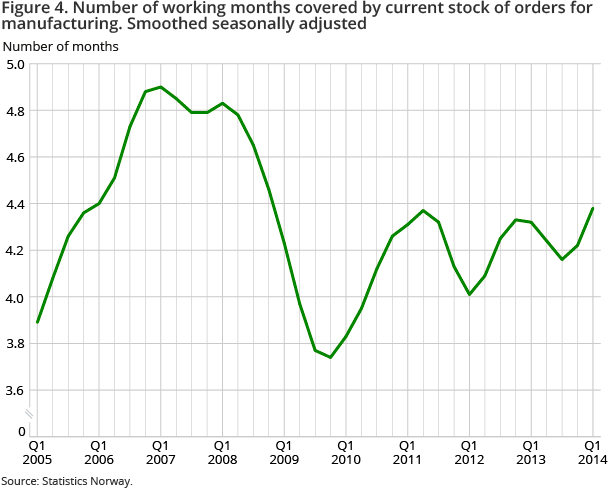
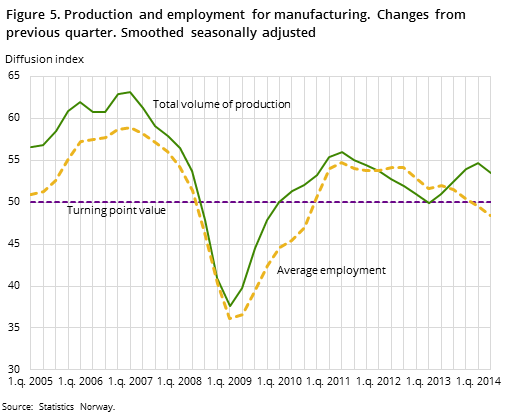
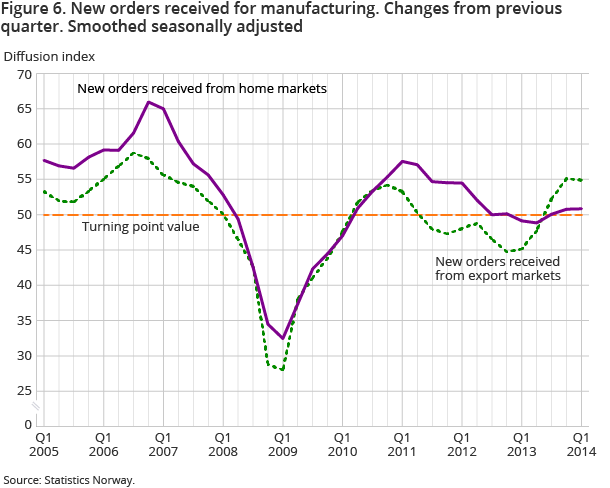
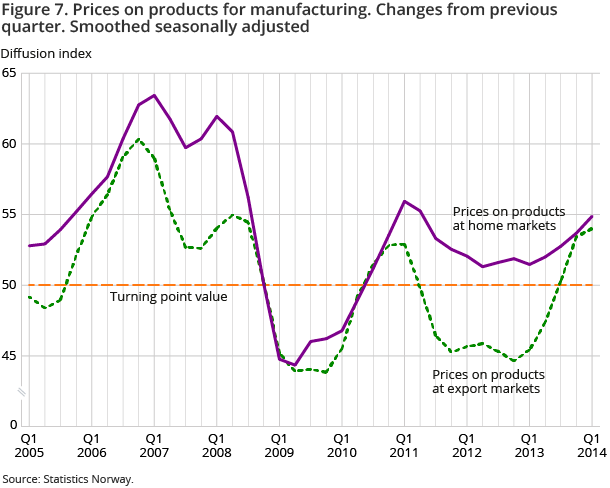
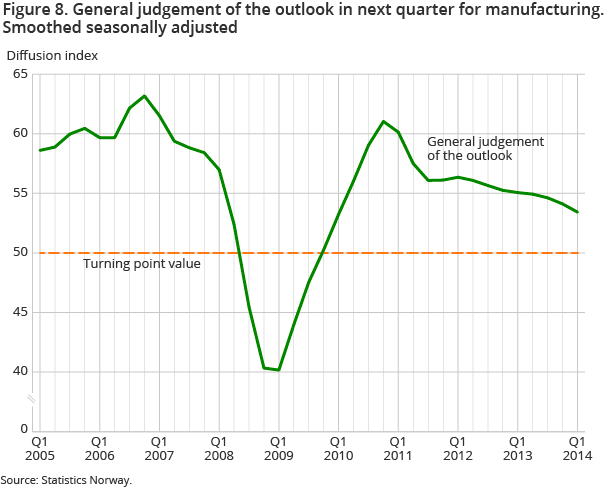
The Business tendency survey for the first quarter of 2014 shows somewhat stronger growth in total output. Higher production of intermediate goods and capital goods explain this development. The improvement was particularly evident within wood and wood products, computer and electrical equipment, machinery and equipment plus repair and installation of machinery. However, manufacturers of basic chemicals and paper and paper products still faced the strongest growth in output. Only a few industries experienced lower activity. The most important were ships, boats and oil platforms, as well as furniture. Total employment was slightly higher than in the fourth quarter of 2013. A further increase in the number of employees within manufacturing of capital goods compensated for a further decline in the number of employees within manufacturing of consumer goods.
Improved conditions in export markets
Total stocks continued to rise in the first quarter of 2014. Higher volumes of new orders and stronger prices in export markets were the reasons for this growth. A weaker Norwegian currency and improved conditions among important trading partners explain this development. The increase in demand from export markets was strongest within manufacturing of intermediate goods and especially among producers of basic chemicals. Other industries that experienced a significant increase in new orders from export markets were computer and electrical equipment and manufacturers of transport equipment. The supply of new orders from home markets was more or less the same as in the second half of 2013, but prices continued to rise. The demand for capital goods continued to fall in the first quarter. A strong decline in new orders for manufacturers of ships, boats and oil platforms was the main cause for this development.
Expectations of further growth in the second quarter
The general outlook for the second quarter of 2014 is considered to be positive, but the optimism was weaker among manufacturers of capital goods. Expectations of a decline in total stocks of orders and no further growth in employment support this finding. The optimism was still quite strong among manufacturers of intermediate goods. A weak Norwegian currency partly explains this fact.
The industrial confidence indicator was higher than the historical average, but went down from 8 to 7 (seasonally-adjusted net figure) in the first quarter of 2014. A decline in the confidence indicator for manufacturers of capital goods explains this fall. Values above zero indicate that total output will grow, while values below zero indicate that total output will fall. International comparisons of the industrial confidence indicator are available from Eurostat (EU), The Swedish National Institute of Economic Research and Statistics Denmark.
Higher capacity utilisation within manufacturing
Average capacity utilisation for the Norwegian manufacturing industry is estimated at 80.4 per cent at the end of the first quarter of 2014. This is the highest level since the second half of 2008, and the growth was particularly strong among producers of basic chemicals. However, average capacity utilisation was still somewhat lower than the historical average. International comparisons of average capacity utilisation are available from Eurostat (EU).
The average number of working months covered by the current stock of orders was noticeably higher than in the corresponding quarter of 2013 and lay above the historical average. Higher stocks of orders within the industries machinery and equipment, non-ferrous metals plus repair and installation of machinery contributed to this rise. The indicator on resource shortage for manufacturing as a whole continued to grow in the first quarter of 2014. This was caused by a further increase in the share of managers reporting full capacity utilisation.
Timeliness
The survey data was collected in the period from 10 March 2014 to 25 April 2014.
Assessment of industries in Q1 2014 and the short-term outlook 1
1 Prospects shows an overall evaluation of the present situation and expected short-term developments 2 Very good: ++, Good: +, Stable: ~, Poor: -, Very poor: --, Good, but with certain negative indications: +(-), A situation where the + and - factors even out: +/-, Poor, but with certain positive indications: -(+) | |
| Industry | Prospects 2 |
| Food, beverages and tobacco | + |
| Wood and wood products | + |
| Paper and paper products | ++ |
| Basic chemicals | + |
| Non-ferrous metals | +(-) |
| Fabricated metal products | +(-) |
| Computer and electrical equipment | + |
| Machinery and equipment | + |
| Ships, boats and oil platforms | - |
| Repair, installation of machinery | ++ |
Additional information
The statistics provide current data on the business cycle for manufacturing, mining and quarrying by collecting business leaders’ assessments of the economic situation and the short term outlook.
Contact
-
Edvard Andreassen
E-mail: edvard.andreassen@ssb.no
tel.: (+47) 40 90 23 32
-
Ståle Mæland
E-mail: stale.maeland@ssb.no
tel.: (+47) 95 05 98 88
